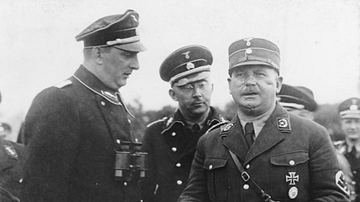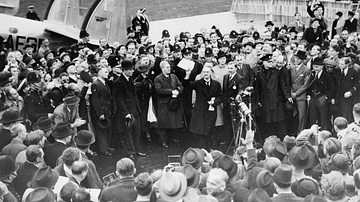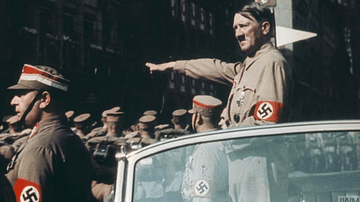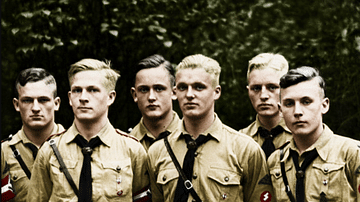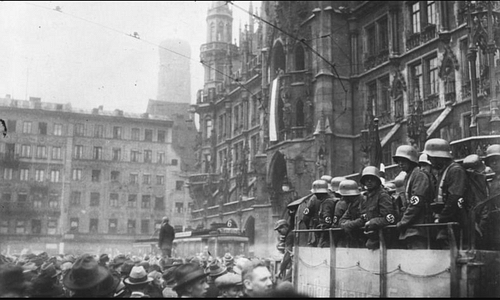
The Beer Hall Putsch or Munich Putsch was a failed attempt by the German National Socialist (Nazi) Party to seize power, first of the Bavarian and then the German federal government on 8-9 November 1923. The coup, led by Adolf Hitler (1889-1945), failed because other right-wing politicians, the police, and the army did not give their support.
The Nazis & the Crisis of 1923
Hitler became leader of the Munich-based NSDAP (National Socialist German Workers' Party) in 1921, taking over from Anton Drexler (1884-1942). The party was neither socialist nor at all interested in workers, but Hitler had chosen the name to give his ultra-nationalist party as wide an appeal as possible. Known as the Nazi Party, it was also vehemently anti-Semitic and against the German establishment, which it saw as the root of all ills, everything from the signing of the humiliating Treaty of Versailles which formally closed the First World War (1914-18) to hyperinflation. The Weimar Republic, as Germany was now known, was beset by weak coalition governments, which struggled to cope with a series of severe post-war challenges. By 1923, the Nazi Party had over 55,000 members, although this was much fewer than the Social Democratic Party, for example, which had 1.2 million members.
In the summer of 1923, the German government was in the middle of yet another crisis. France had invaded parts of the heavily industrialised Ruhr in western Germany in order to force the country to make good on its obligations to pay France war reparations. The government declared a state of emergency, and the army was given chief executive power. In Munich, the leader of the local government, Gustav Ritter von Kahr (1862-1934), the local army chief, and the chief of the police force were all given extraordinary powers to deal with the crisis. All were right-wing in political orientation, and Hitler saw this as an opportunity to take power, or, even better, to force an invitation to take power from what he considered like-minded politicians and army figures. Hitler ultimately intended to march on Berlin, much like the Italian fascist dictator Benito Mussolini (1883-1945) had marched on Rome to seize power in October 1922 (when the Italian king felt obliged to invite him to power). First, Hitler would deal with Munich, and his primary weapon would be his own paramilitary followers.
The Nazis used a paramilitary group, the SA (Sturmabteilung) stormtroopers, to frequently rough up the political opposition and generally strut about looking important. The SA, led by Ernst Röhm (1887-1934), even became too powerful for Hitler's liking, and so he created his own personal bodyguard called the Stosstrupp-Hitler (Hitler Shock Troop). Stosstrupp members included Julius Schreck (1898-1936), Joseph Berchtold (1897-1962), Ulrich Graf (1878-1950), Hermann Göring (1893-1946), and Rudolf Hess (1894-1987). Other key supporters of Hitler included General Erich Ludendorff (1865-1937), the WWI veteran who had found himself out of favour with the Weimar establishment ever since the armistice. Hitler hoped General Ludendorff would be a respectable figurehead for a Nazi-driven coup d'etat.

Storming the Beer Hall
Hitler selected his first point of confrontation: a beer hall in Munich. Around 8:30 p.m. on 8 November 1923, he and a number of the Stosstrupp-Hitler surrounded the Bürgerbräukeller while, inside, von Kahr was giving a speech to an audience of important government officials and business people. Hitler had actually thought von Kahr was about to stir up his audience and announce a revolution, or at least some sort of act of Bavarian separatism from the federal government. In fact, von Kahr had already abandoned this idea as far too risky and very unlikely to succeed without the army's support. Hitler barged into the hall with his machine-gun-wielding men, fired his pistol off at the ceiling, and then brandished his gun at von Kahr, boldly announcing "The National Revolution has begun!" (Stone, 34). One eyewitness, a historian called Müller, recalls the scene that night:
Herr von Kahr had spoken for half an hour. Then there was a movement at the entrance as if people were wanting to push their way in. Despite several warnings, the disturbance did not die down. Herr von Kahr had to break off speaking…I saw him [Hitler] emerge between two armed soldiers in steel helmets who carried pistols next to their heads, pointing at the ceiling. They turned towards the platform. Hitler climbed on to a chair to my left…Thereupon Hitler called out…'The National Revolution has broken out. The hall is surrounded'…The gentlemen [on the podium] did not move...I heard him [Hitler] talk to the gentlemen and I heard the words: Everything would be over in ten minutes if the gentlemen would go with him…
After von Kahr and Hitler had disappeared in a back room for around ten minutes, Hitler re-entered the main hall. Müller continues the story:
[Hitler] went to the platform and made a short speech. It was a rhetorical masterpiece. In fact, in a few sentences it totally transformed the mood of the audience. I have rarely seen anything like it.
(McDonough, 114-5)

The March for Power
Meanwhile, Röhm and the SA had taken over several Munich government buildings, including the War Ministry. Hitler talked with von Kahr and his associate Colonel Hans von Seisser, the head of the Bavarian state police, in private, as noted by Müller, but they failed to make the Nazi leader see that without the cooperation of the army chief in Berlin, General Hans von Seeckt, there could not possibly be a coup. After making the deluded Hitler some easy promises of collaboration in the 'revolution' and speaking again to the crowd still in the beerhall, von Kahr and the others were released. Seisser and von Kahr immediately proceeded to move the wheels of power to ensure this upstart Nazi would get precisely nowhere in his coup.
Hitler may have already realised the game was up, but he had little choice but to press on if he was to retain any vestige of respectability amongst his own party. Hitler even told his followers in the beer hall, "If this works out, fine. If not, we'll all hang ourselves" (Range, 386). By now it was morning, and Hitler, with his followers and Ludendorff in tow, marched from the beer hall and through the streets to the War Ministry in order to link up with Röhm. Things then really started to fall apart for the conspirators.
When Hitler and his 2,000 marchers reached the memorial square of Odeonsplatz they came face to face with 100 armed policemen. Meanwhile, the army had surrounded the War Ministry, although no shots had been fired. The police stood firm when asked to move aside and let the march proceed. Then a shot rang out. Which side shot first is disputed, but the result was the killing of a policeman. The police then fired at the marchers. The man standing next to Hitler, actually with his arm in the leader's, was shot in the chest, and as he fell to the ground, he dislocated Hitler's arm. Ulrich Graf threw himself in front of his leader and was also shot. Others to receive non-fatal bullet wounds included Göring and Berchtold. Five members of the Stosstrupp-Hitler and eleven other Nazis were killed in the incident. Another two policemen were killed. The banner of the Reichskriegflagge (Imperial War Flag), carried by Heinrich Himmler (1900-45) during the putsch, was bloodied in the incident and, once recovered later from the police, was thereafter treated like some sort of holy relic by the Nazi faithful. The flag was even given a special name, the Blutfahne or 'Banner of Blood'. Ludendorff continued the march on his own, but Hitler and his inner circle, realising that the state forces had already taken the upper hand, drove away to what they thought was the safety of the countryside. The putsch had failed spectacularly.

Why Did the Putsch Fail?
The Beer Hall Putsch failed because Hitler's plan was naive and hopelessly ambitious. He underestimated the strength of his opponents and overestimated the ambition and courage of his allies, who turned out not to be allies at all. Hitler also badly underestimated the loyalty of the army to the Weimar regime, the unpopularity of Ludendorff because of his association with the armistice, and the general distaste for the Nazis and their violent methods, even amongst right-wingers. Hitler, whose ideas at this stage were still a mix of left and right politics, had alienated himself from figures like von Kahr with some of his left-wing ideas and his refusal to cooperate with other right-wing paramilitary groups. In any case, even if Hitler had gained control of Munich, to achieve the same end regarding the federal government was quite another matter since the army chief Seeckt had already firmly rebuffed Hitler's approaches for collaboration. The fragile Weimar government was, above all, desperate not to provoke another violent backlash from the left and endure a general strike by the trade unions, exactly what had happened in another botched right-wing coup back in 1920, this time in Berlin. In short, Hitler's timing was all wrong, and his choice of potential enablers was poor. Even if the putsch had been successful, the Nazi party had no structure and no ideas for actually governing Germany besides introducing systematic attacks on its enemies and imposing the death penalty for all sorts of trivial offences. Hitler would have to wait another decade for the stars of German politics to align themselves in his favour.
The Consequences of the Putsch
The day after the failed coup, Hitler was arrested for treason, along with many of his associates. Of the key Nazis at the putsch, only Hess and Göring escaped arrest since each had fled separately to Austria. Hitler was found guilty in his trial in February 1924, but he used the proceedings as a platform to make a long speech promising he would eventually become Germany's leader. Hitler was sentenced to five years in prison, but actually, thanks to a sympathetic judge, this was the minimum term he could have served for such a grave offence against the state. Hitler was imprisoned in Landsberg Prison along with several of his supporters, including such figures as Himmler, Röhm, and Hess. The Stosstrupp-Hitler was disbanded, and both the Nazi Party and SA were banned (although only temporarily). The SA (under the temporary new name of Frontbann) rose in membership from 2,000 at the time of the putsch to 30,000 a year later. The publicity of the trial and Hitler's oratory skills in court had done no harm at all to the Nazis' popularity.
Hitler spent his confinement, a not uncomfortable one where he had regular visitors, writing a highly selective biography that also set down his outlandish dreams for a future Germanic state that would dominate the world. The title was Mein Kampf, meaning 'My Struggle'. On his release in December 1924 (he was let out early for good behaviour), Hitler continued to promote national socialism, but this time using only peaceful means. Mein Kampf was published in 1925.
The Nazi Party was eventually successful enough in the 1932 election for Hitler to be invited to become the chancellor of Germany. Hitler, wary of Röhm and the SA's growing power, created a rival paramilitary group, the Schutzstaffel or SS, which was loyal to Hitler personally. The SA leadership was destroyed and Röhm executed in the Night of the Long Knives in the summer of 1934. In the same purge, Hitler ensured von Kahr paid for his betrayal; the retired councillor was executed by the SS.
From 1933, all those who had participated in the Beer Hall Putsch, which, thanks to persistent propaganda, had by now become a legendary escapade in the history of nazism, were given a medal to wear with pride, the Blutorden or 'Blood Order'. Many veterans of the Beer Hall Putsch were later rewarded with choice positions of power: Himmler was made head of the ever-growing SS, Göring became head of the Gestapo (secret police) and then the Luftwaffe (German Air Force), and Goebbels was appointed Minister of Propaganda. An SS guard was permanently posted at the Odeonsplatz throughout Hitler's reign, and the square's Feldherrnhalle monument, which included the tombs of the 16 'martyrs' to the cause, was a constant point of pilgrimage by pro-Nazis. The site was honoured by a Nazi commemoration ceremony each 9 November, and the day itself became an official Nazi holiday, one where Hitler returned to the Bürgerbräukeller to give a speech. The Banner of Blood was not forgotten either and was used to consecrate Nazi party flags in important public ceremonies such as at the annual Nuremberg Rally, the massive Nazi gathering held each September (except one) from 1927 to 1938.



